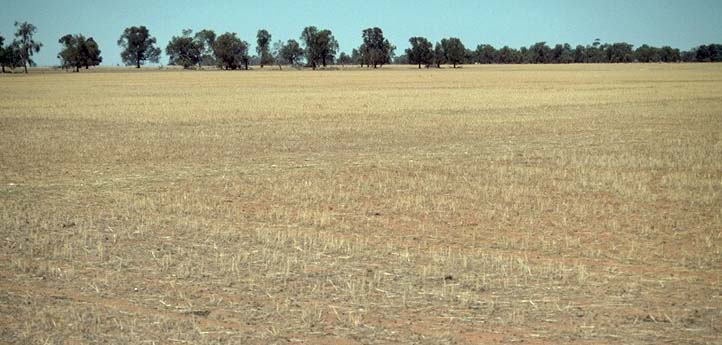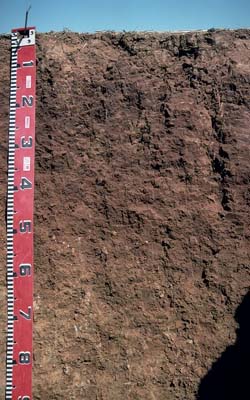LP52
| Property: LP52 Wanurp | Group: Pine Grove Farm Advance |
| Australian Soil Classification: Calcic, Hypernatric, Red SODOSOL | Northcote Factual Key: Dr 2.33 |
| Great Soil Group: red-brown earth | |
| General Landscape Description: Old alluvial plain that was originally relatively treeless apart from Buloke (Casuarina luehmanii). | |
 LP52 Landscape |
Soil Profile Morphology
Surface Soil
| A1 | 0-8 cm | Dark brown (7.5YR3/4); light fine sandy clay loam; hardsetting and massive; strong consistence dry; pH 6.4; sharp change to: |  LP52 Profile |
| A2 | 8-10 cm | Strong brown (7.5YR4/6), sporadically bleached; light fine sandy clay loam; massive; strong consistence dry; pH 6.6; sharp change to: | |
| Subsoil | |||
| B21 | 10-30 cm | Yellowish red (5YR4/6); medium heavy clay; moderate coarse blocky structure; very firm to strong consistence dry; pH 8.7; gradual change to: | |
| B22 | 30-55 cm | Yellowish red (5YR4/6); light medium clay; moderate coarse blocky structure; very firm to strong consistence dry; pH 8.2; gradual change to: | |
| B31 | 55-100 cm | Yellowish brown (10YR5/6) with yellowish red (5YR5/8); light medium clay (fine sandy); strong medium polyhedral structure; firm consistence moist; contains a few (2-5%) hard carbonate nodules as well as pockets of gypsum; pH 8.9; gradual change to: | |
| B32k | 100 cm+ | Brown (10YR5/3) light clay (sandy); strong medium polyhedral structure (with shiny-faced peds); firm consistence moist; contains a few (2-10%) fine-earth and hard carbonates; pH 8.9. | |
| NOTE: This soil corresponds partly to Koga Clay Loam as mapped by Skene and Harford (1964). | |||
Key Profile Features
- Hardsetting surface horizon (with a high fine sand content of 49%).
- Strong texture contrast between surface (A) horizons and subsoil (B) horizons. (i.e. clay percentage of A horizon is 25%, compared to 52% for the B21 horizon).
- Coarsely structured subsoil (strongly sodic).
Key Profile Characteristics
pH | Salinity Rating | |||
Surface (A1 horizon) | slightly acidic | low | Marginally sodic | none1 |
Subsoil (B21 horizon) | strongly alkaline | medium | strongly sodic | complete |
Deeper subsoil (at 1 m) | strongly alkaline | high-very high | strongly sodic | _ |
| 1 Strong dispersion after remoulding. | ||||
 |
Horizon | Horizon Depth | pH (water) | EC 1:5 | NaCl | Exchangeable Cations | |||
Ca | Mg | K | Na | |||||
meq/100g | ||||||||
A1 | 0-8 | 6.4 | 0.14 | 2.7 | 3.4 | 0.6 | 0.5 | |
A2 | 8-10 | 6.6 | 0.12 | 2.4 | 3.1 | 0.4 | 0.9 | |
B21 | 10-30 | 8.7 | 0.71 | 0.12 | 5.9 | 11 | 0.9 | 8.4 |
B22 | 30-55 | 8.2 | 0.35 | 0.07 | 5.1 | 7.8 | 0.8 | 4.8 |
B31 | 55-100 | 8.9 | 1.14 | 0.18 | 3.4 | 7.2 | 0.6 | 6.3 |
B31k | 100+ | 8.9 | 1.74 | 0.3 | 4.1 | 9.3 | 0.7 | 8 |
Horizon | Horizon Depth | Ex Al mg/kg | Ex Ac meq/100g | Field pF2.5 | Wilting Point pF4.2 | Coarse Sand (0.2-2.0mm) | Fine Sand (0.02-0.2mm) | Silt (0.002-0.02mm) | Clay (<0.002mm) |
A1 | 0-8 | 21 | 10 | 10 | 49 | 15 | 25 | ||
A2 | 8-10 | 20 | 9.7 | 9 | 49 | 18 | 25 | ||
B21 | 10-30 | 35.2 | 21.4 | 5 | 32 | 13 | 52 | ||
B22 | 30-55 | ||||||||
B31 | 55-100 | ||||||||
B31k | 100+ |
Management Considerations:
- In general, management strategies for all soils should aim to increase organic matter levels in the surface soil; minimise the degradation of soil aggregates and porosity; promote the development of stable biopores; improve the calcium status of the ion exchange complex (particularly when sodium is a significant part – i.e. sodic), and break up any hardpans. Less frequent tillage; using less aggressive implements, and working the soil at optimum moisture conditions can all assist in maintaining soil aggregation and porosity as well as reducing the breakdown of organic matter. Practices such as residue retention, minimum tillage and including pasture rotations could be utilised if cropping takes place in order to build up organic matter, reduce erosion risk and increase fertility.
- Plant available water capacity (PAWC) is relatively low (estimated at 64 mm) for this profile - based on the laboratory data available. PAWC is limited by the strongly sodic subsoil and the high salinity at 55 cm.
Surface (A) Horizons
- Surface horizon has a low overall nutrient status (based on the sum of the exchangeable basic cations)
- Surface horizon is marginally sodic and disperses strongly after remoulding. This suggests that dispersion may occur if soil is cultivated or overstocked when wet and that surface sealing may result on drying. Heavy rains falling of such soil when cultivated may also promote surface sealing and compaction. Gypsum is usually an effective ameliorant on such soils.
- Improving organic matter levels will assist in minimising structural problems such as crusting and hardsetting as well as improving soil fertility and water holding capacity.
- The subsurface (A2) horizon is sodic and completely disperses in water. It has the potential to develop into a hardpan if it is excessively worked in a wet condition.
Subsoil (B) Horizons
- The coarsely structured subsoil is strongly sodic and completely disperses in water. These factors indicate that water and root movement through the profile will be restricted. (The presence of a sporadic bleach above this horizon indicates that water movement into the subsoil is restricted).
- The top of the subsoil has a medium soil salinity rating - this may restrict the growth of salt sensitive species (e.g. maize, and many legumes). The salinity rating increases with greater depth down the profile and may restrict the growth of a number of salt-sensitive species.
- The top of the subsoil is strongly alkaline, indicating that some nutrients (e.g. phosphorus, iron, manganese and zinc) may be poorly available to plants.
Notes:
Profile described by Mark Imhof, Paul Rampant and Karen de Plater (2/3/95)


